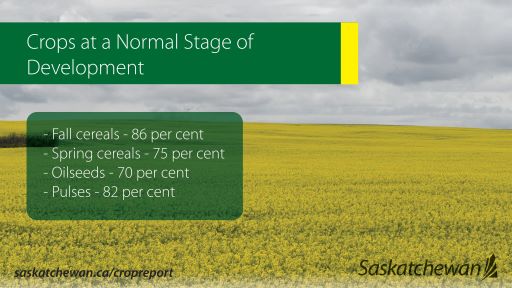Released on July 16, 2020
Warm weather and rainfall this week continued to support crop development. Currently, 86 per cent of the fall cereals, 75 per cent of the spring cereals, 70 per cent of the oilseed crops and 82 per cent of the pulse crops are at a normal stage of development for this time of year.
The majority of crops this week are in fair to excellent condition. Rainfall was received throughout the province this week. Areas near Neilburg received the highest amount of rainfall in the province with 116 mm.
The St. Walburg area received the most rainfall in the province since April 1 with 376 mm. The moisture was welcome in many areas, but high amounts of rain in certain parts of the west-central and northern regions resulted in localized flooding and standing water. This prevented producers from entering fields for spraying and haying.
Cropland topsoil moisture is rated as six per cent surplus, 85 per cent adequate, six per cent short and three per cent very short. Hay and pasture land topsoil moisture is rated as four per cent surplus, 75 per cent adequate, 16 per cent short and five per cent very short. Rainfall this week delayed some farmers from haying, but hay is being cut and baled as conditions allow.

Livestock producers now have 13 per cent of the hay crop cut and 11 per cent baled or put into silage. Hay quality is rated as five per cent excellent, 65 per cent good, 25 per cent fair and five per cent poor.
The majority of crop damage this week was caused by flooding, hail, wind, lack of moisture, lodging, gophers and insects. There have been reports of disease issues in most regions of the province, including root rot and ascochyta blight in pulses. Some producers have started spraying for fusarium head blight and other diseases as environmental conditions permit.
Farmers are busy haying, spraying fungicides, fixing equipment and scouting for insects and disease.
A complete, printable version of the Crop Report is available online at www.saskatchewan.ca/crop-report.
Follow the 2020 Crop Report on Twitter at @SKAgriculture.
-30-
For more information, contact:
Sara Tetland
Agriculture
Moose Jaw
Phone: 306-631-0483
Email: Sara.Tetland@gov.sk.ca

